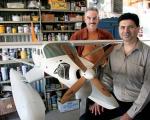It's plane sailing for our engineers
 Engineering Engineering
The University of Adelaide has joined forces with a local aviation company to develop a world first - a prototype for an amphibious seaplane with retractable floats. The School of Mechanical Engineering is collaborating with Tigerfish Aviation to develop the retractable floats for seaplanes, allowing them to land on either water or a runway. A $300,000 State Government strategic grant has paved the way for the ambitious project, which has the potential to revolutionise the seaplane industry in Australia and around the world. Initially intended for the general aviation sector, if the prototype is successful, the concept could appear on larger, passenger aircraft. Dr Bassam Dally, a senior lecturer at the School of Mechanical Engineering, has been instrumental in establishing the collaboration with Tigerfish Aviation directors Saxon Rudduck and Alan Smith. The idea has been developed and patented by Tigerfish Aviation but, due to the low level of funding, its design and implementation has been slow until now. Dr Dally said that existing seaplanes could not retract their floats, resulting in a large air resistance or drag. "This makes them very inefficient because they use more fuel and are therefore restricted with the distances they travel or the load they can carry," Dr Dally said. "Retro-fitting the retractable floats to existing aircraft is an attractive and financially viable option." "The modifications are not expected to be huge and if companies are using the plane on a regular basis, they will recoup their investment very quickly," Dr Dally said. The retractable float development will be applied to two aircraft - the 12-14 seat Cessna Caravan (which has both a seaplane and a land version) and the Dash 8, a larger passenger plane, which can seat 37-50 people. Additional funding of $60,000 has been pledged from the Sir Ross & Sir Keith Smith Fund, named after two pioneering South Australian aviators who in 1919 flew a Vickers Vimy biplane from London to Darwin in less than 28 days. The fund aims to advance the science and education of aeronautics in South Australia. Another academic from the School of Mechanical Engineering, Dr Gerald Schneider, a Sir Ross & Sir Keith Smith Fund lecturer in aerospace engineering, will also be involved in the project. Dr Schneider said the prototype had applications for rescue missions, supply ships and emergency landings. "It will give pilots another option to land in the sea rather than on rough terrain if an emergency arises," Dr Schneider said. "This project has both commercial and academic significance," Dr Dally said. "It will help publicise our work in the field of aeronautical engineering and opens up new opportunities for research. In addition it has huge potential for the development of the commercial aviation industry in Australia." The proof of concept on scaled planes as well as existing models is aimed at attracting further State and Federal support as well as substantial investment in the order of $3 million over the next four years. Story by Candy Gibson
|




